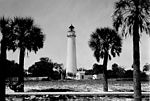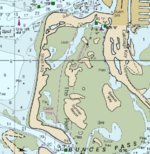Fort De Soto Park
1962 establishments in FloridaBeaches of FloridaBeaches of Pinellas County, FloridaFlorida in the American Civil WarFormer populated places in Pinellas County, Florida ... and 9 more
Ghost towns in FloridaMilitary and war museums in FloridaMilitary facilities on the National Register of Historic Places in FloridaMuseums in Pinellas County, FloridaNRHP infobox with nocatNational Register of Historic Places in Pinellas County, FloridaParks in Pinellas County, FloridaProtected areas established in 1962Use mdy dates from May 2019

South-southwest of St. Petersburg, Florida, Fort De Soto Park is a park operated by Pinellas County on five offshore keys, or islands: Madelaine Key, St. Jean Key, St. Christopher Key, Bonne Fortune Key and the main island, Mullet Key. The keys are connected by either bridge or causeway. The island group is accessible by toll road from the mainland. Historically, the islands were used for military fortifications; remnants and a museum exhibit this history. Two piers, beaches, picnic area, hiking trails, bicycling trails, kayak trail, and a ferry to Egmont Key State Park are available. The park is a gateway site for the Great Florida Birding Trail.
Excerpt from the Wikipedia article Fort De Soto Park (License: CC BY-SA 3.0, Authors, Images).Fort De Soto Park
Original Brick Road 1898,
Geographical coordinates (GPS) Address Nearby Places Show on map
Geographical coordinates (GPS)
| Latitude | Longitude |
|---|---|
| N 27.615499 ° | E -82.735902 ° |
Address
Battery Laidly
Original Brick Road 1898
Florida, United States
Open on Google Maps









